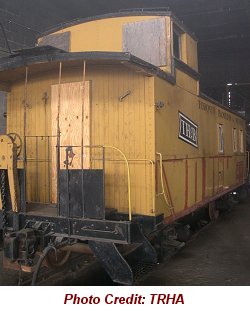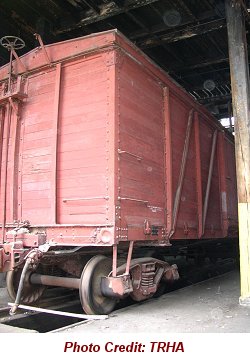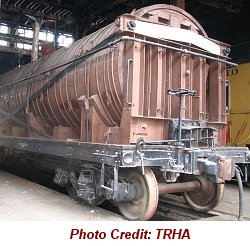


Toronto, Hamilton & Buffalo Caboose #70
 |
This steel-sheathed, woodside caboose was constructed in 1921 by the TH&B Railway in its Aberdeen (Hamilton) shops using some components from caboose 51 acquired in 1907 from the Michigan Central Railroad Its present appearance came about in the 1950's when steel sheathing was added. Around 1954-1955 it received the yellow paint scheme already being applied to their boxcars since early 1952. the TH&B chose yellow and black from the colours of the Tiger Cats football team in Hamilton.
In addition to rear-end manual braking control, the purpose of the caboose was to provide a home-away-from-home for train crews while out on the road. In the steam era, freight train crews typically consisted of five men: the conductor, in charge of the train like the captain of a ship; the engineer, responsible for driving the locomotive; the fireman, responsible for maintaining boiler pressure, fuel and water supplies, etc.; and two brakeman, assigned to assist in switching and other train operations by applying brakes manually on standing freight cars, throwing switches, etc. One brakeman routinely rode in the locomotive cab with the engineer and fireman, while the other brakeman rode in the caboose with the conductor. Until after World War II, there was no way for the engine crew to contact the caboose crew - which could be 3000 and more feet away on a long freight train - except by whistle, hand signals or lights. Radio revolutionized on-board train operations. The caboose contained a variety of accommodations, including office space for the conductor to take care of the paperwork associated with dropping off and picking up freight, as well as notices concerning the condition of the rolling stock and the state of the track. There were also bunks which served as benches during the day. Often the crews would use their assigned caboose as a hotel when they had to layover at a terminal away from home. In addition to a stove for heating and cooking, the caboose often contained a source of drinking water and even an icebox on occasion. Until very late in their history, cabooses never had amenities such as toilets or showers. A characteristic feature of the caboose is the cupola on the roof. This is an elevated observation post from which the crew can observe the behaviour of the train ahead. The cupola usually featured a brake line pressure gauge and an emergency brake valve - just in case. As freight cars grew in height and length during the 1960's, the cupola gradually became useless and many railroads began to use cabooses equipped with bay windows instead. Ultimately, with the reduction in train crew sizes from five to three and now even two people, as well as the perfection of braking equipment and of rear-end telemetry devices, the caboose was largely withdrawn from service in North America in the 1980's. Some remain in use where industrial switching operations required lengthy backup moves. The Toronto, Hamilton and Buffalo Railway existed from1892 through 1987 as a separate railway serving the Hamilton area. It joined lines of its corporate parents, Canadian Pacific and New York Central (now CSX), and was established as alternative to the Grand Trunk or Canadian National route for Hamilton-area industries to ship products to customers in the United States and Canada. This car has been generously donated by the Toronto & York Division of the Canadian Railroad Historical Association to the City of Toronto. |
Canadian Pacific 188625 - Fowler boxcar, built 1917
 |
CP 188625 represents the typical 36 foot long wooden boxcar that roamed
the rails carrying freight all across Canada and the U.S.A. for half a century, a few lasting until the 1960's. These boxcars carried wheat and other grains to market along with manufactured goods of all kinds.
Our boxcar is one of 33,000 such cars built between 1896 and 1914. These would form a train 225 miles long! These wooden single-sheathed steel frame boxcars had a capacity of 40 tons and a tare weight of 20 tons and 2,448 cubic feet of space. They were outfitted with archbar Simplex trucks. Other railroads across the continent also used tens of thousands of similar cars. They were designed by W. E. Fowler, CPR Master Car Builder, who later patented this weight-saving design which became known as the Fowler boxcar. Prior to the Fowler design, boxcars typically had wooden structural members sandwiched between an interior and exterior wooden skin. The Fowler car eliminated the exterior layer of wood, producing a cheaper, lighter car that could carry a greater payload. This design also prevented grain leakage at seam between the floor and the side of the car. The Fowler boxcars were generally used to carry grain and other dry bulk commodities until about 1960, when they began to be replaced by specialized top-load/bottom-discharge covered hopper cars. Dry bulk commodities shipped in boxcars were literally poured into the open doorway of the car, into which a bulkhead four to six feet high had been inserted to form a largely closed box. When the car arrived at its destination, it was usually unloaded by men with shovels. This was an expensive and laborious process, particularly in Canada where transportation of grains, ores and other dry bulk commodities were so significant to the economy. This car has been generously donated by the Toronto & York Division of the Canadian Railroad Historical Association to the City of Toronto. |
Reinhart Vinegars RVLX 101 - wooden vinegar tank car, built 1938
 |
This rare vinegar tank car was constructed for Reinhart Vinegars in 1938. It has a steel frame atop which ride wooden tanks specially designed to transport vinegar from Reinhart’s facilities to industrial consumers in southwestern Ontario – for example, pickling plants and other food preparation concerns.
The car was a regular feature of local freight trains in the Toronto area for 38 years and is one of only two of its type in existence (the other is at the St. Louis Museum of Transport). This car has been generously donated by the Toronto & York Division of the Canadian Railroad Historical Association to the City of Toronto. |